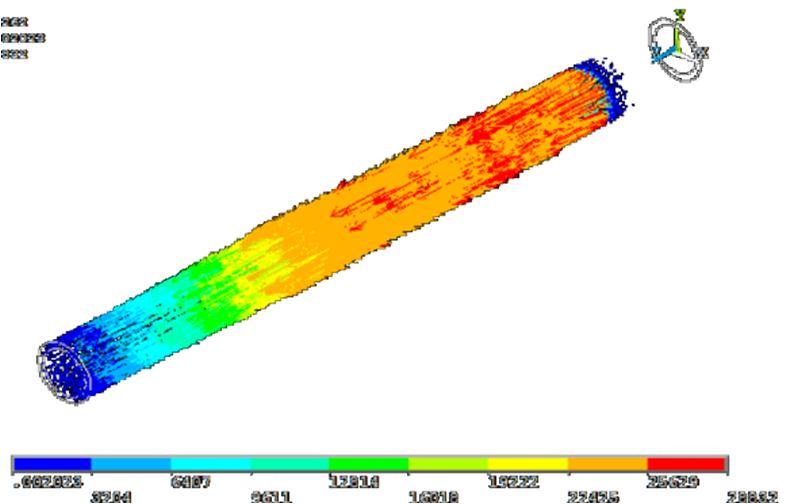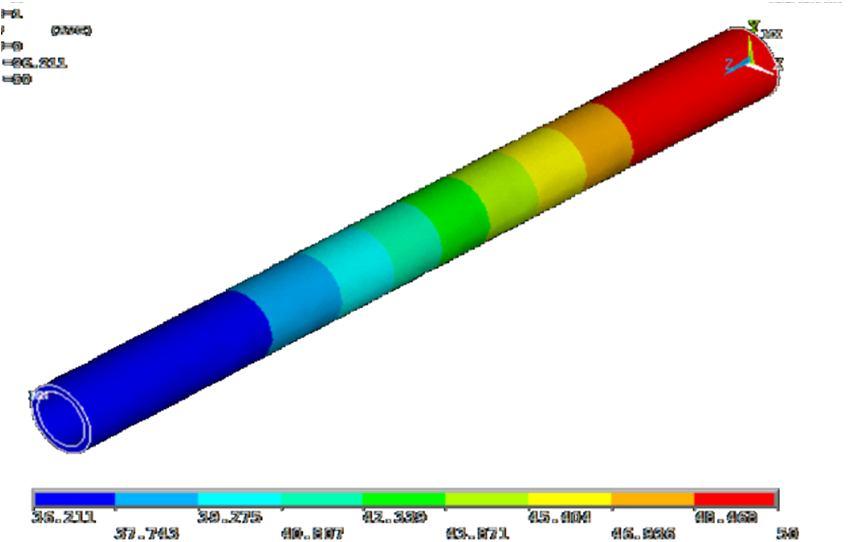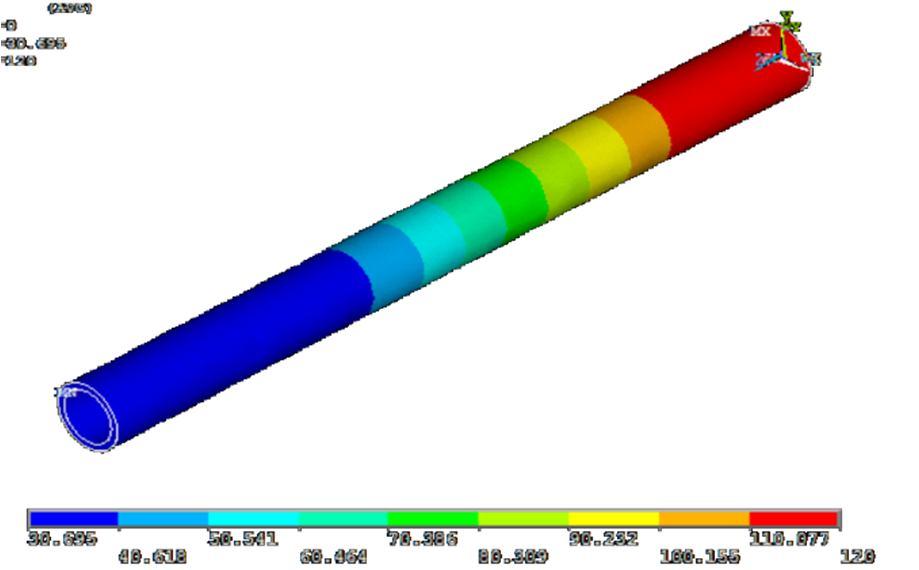
ISSN: 2321 9653; IC Value:


ISSN: 2321 9653; IC Value:

Abstract: Researcher undergoes with various research activities to minimize the energy wastage and a researchers drawn their attention towards the recovery or storage of wasted energy but still there is a need of proper application and execution of the done research. The heat depletion through heat pipe heat exchanger is an excellent device to recover waste energy. The heat pipe heat exchanger not only is the effective way of storing the waste thermal energy but also it also prevents global warming. Heat pipes are inert, extremely consistent and provides with high heat transfer rates with minimal heat loss. These heat pipes are finding their way into sensitive applications such as notebook computers. A heat pipe is designed for cooling application in a computer has been evaluated through thermal analysis. The developed model of heat pipes used to draw a comparison with various parameters.
Keywords: Heat Pipe; Finite Element; Thermal distribution; Heat Flux
The heat pipe has been invented near the turn of the 20th century and early heat pipes were constructed out of hollow metal tubes that were sealed at both ends, vacuumed, and charged with a small quantity of evaporative fluid [1 4]. They contained a "wick" to transport the fluid from one end of the heat pipe to the other. The schematic diagram of heat pipe is represented in Fig.1[1]

The energy absorbed and released from the phase change of the fluid; the hollow heat pipe allowed an extremely fast heat transfer. Heat applied to one end of the pipe would almost instantaneously evaporate the fluid inside [5,6]. This vapor would then move to the other, colder end of the pipe where it quickly condensed back into a liquid, releasing the heat absorbed during the evaporation. The fundamental structure of a heat pipe comprises with an emptied cylinder involved with a working liquid that exists in both fluid and vapor stages [7,8].
Feng cai [9] experimentally evaluated the heat transfer under steady state condition for copper heat pipes. The experimental tests were conducted with copper pipe charged with water, acetone and nickel foam. All these pipe configurations were tested with insulation and three orientations: horizontal, gravity assisted vertical, and against gravity vertical. These heat pipes were also cooled by natural forced and enhanced forced convection approaches. Senthil et al. [10] investigated the effect of different inclination angle, heat contribution and thermal resistance on the performance of copper heat pipe containing nanofluid. It is observed that the heat effectiveness of the heat pipe improves about 10% when copper nanofluid is utilized as a working liquid than the DI water. Roger et al. [11] examined open loop pulsating heat pipe with water copper nanofluid. The physical presence of solid nano particles inside working fluid results the expansion of its nucleation destinations development. Subsequently, higher thermal conductance observed the most extreme heat transport rate Gian et al. [12] Experimentally tested the stainless steel loop heat pipe with a flat evaporator.

Technology (IJRASET
ISSN: 2321 9653; IC Value: 45.98; SJ Impact Factor: 7.538

Volume 10 Issue IX Sep 2022 Available at www.ijraset.com
The result appeared the thermal qualities of a loop heat pipe (LHP) with the evaporator in the state of a flat plate having a functioning distance across of 50 mm and a thickness of 13 mm. The loop and the wick are made of stainless steel and water is utilized as working liquid. Kiseev et al. [13] examined experimentally the thermal performance of dual diameter circular heat pipe under different working fluids such as water, methanol and ethanol. The result demonstrated that higher thermal transfer Coefficients predicted for water as compared with the ethanol methanol mixture This is happened on account of methanol; the thermal transfer Coefficient decrease at high heat transitions which can be because of surface dry out impact. Heat pipes are a special class of heat transfer devices with large heat transfer capacity and least response time. They use latent heat of evaporation and condensation for heat absorption and rejection. They have near isothermal operating conditions and are available in a wide range of shapes and sizes. The heat pipe allows an adequate cross section for heat flow even for very small diameter. These heat pipes are finding their way into sensitive applications such as notebook computers. A heat pipe designed for cooling application in a computer has to be evaluated thermally by making design calculations
The main objective of present article is to create a mathematical model of heat pipes with phase change material by performing thermal analysis.
The present heat pipe is consisting of three sections as shown in Fig.2: a) Evaporator section, b) Adiabatic section, c) Condenser section. In the evaporator section i.e. at heat source working fluid vaporizes and converts into vapor. Then this vapour is passed through an adiabatic section (where no heat loss occurs) to condenser Section (heat sink) where latent heat of fluid releases to surroundings. Temperature of working fluid always exists between triple point and critical point. Working fluid always remains in saturated state inside the heat pipe.

Fig.2 Cross sectional view of heat pipe

The heat pipe fabricated with copper and stainless steel respectively consisting identical cylindrical geometry aspects. The specification for the heat pipe is represented in Table.1. One end of these heat pipe is proved with heat flux of 200W/m2 while the tanks acting while the tanks acting as heat sinks at the other end.
Table.1: Specifications for the heat pipe
Heat Pipe
Steel Pipe
Pipe
of Each Pipe
Sink
Fluid in Each Pipe
Heat balance equation for heat pipe from Fourier
Heat
Also, the total thermal resistance of the heat
heat
evaporator
× 100mm ×60mm
change
and erythritol
condenser
ISSN: 2321 9653; IC Value: 45.98; SJ Impact Factor: 7.538

Volume 10 Issue IX Sep 2022 Available at www.ijraset.com
The finite element method is proposed for a thermal analysis for the fabricated heat pipe and to obtain feasible solutions to a variety of problems. The basic steps involved in any finite element analysis consist of the following:


1) Create and discretize the solution domain into finite elements; that is, subdivide the problem into nodes and elements.
2) Assume a shape function to represent the physical behavior of an element; that is, a continuous function is assumed to represent the approximate behavior (solution) of an element.
3) Develop equations for an element.
4) Assemble the elements to present the entire problem. Construct the global stiffness matrix.
5) Apply boundary conditions, initial conditions, and loading.

1) Solve a set a linear or nonlinear algebraic equations simultaneously to obtain nodal results, such as displacement values at different nodes or temperature values at different nodes in a heat transfer problem.
1) Obtain other important information.
2) In general, there are several approaches to formulating finite element problem involved direct formulation, The minimum total potential energy formulation and Weighted residual formulations.
The results of the grid convergence for heat pipe made of copper and stainless steel accomplish with Phase change material Paraffin and erythritol is shown Fig.3.
results showed that
the range from 20
The present work made the following conclusion:
ISSN: 2321 9653; IC Value:
SJ Impact Factor:

at www.ijraset.com
the axial thermal

stainless steel.
1) The Phase change material Paraffin and erythritol plays significantly role in the the execution of the heat extraction as compared to other heat pipe materials
2) It is seen that for a heat pipe with copper performs superior other than heat pipe materials.
[1] GroverG,CotterT,EricksonG.Structuresofveryhighthermalconductance[J].JournalofAppliedPhysics,1964,35(6):19901991.
[2] Fadhl B, Wrobel LC, Jouhara H. CFD modelling of a two phase closed thermosyphon charged withR134a and R404a[J]. Applied Thermal Engineering, 2015,78:482490.


[3] Yu Le, Liu Jianjun. Stability of interbed for salt cavern gas storage in solution mining considering cuspdisplacementcatastrophetheory.Petroleum,2015,1(1):8290.
[4] Schmidt E. Heat transmission by natural convection at high centrifugal acceleration in water cooled gas turbineblades[J].ProcGeneralDiscussiononHeatTransfer,1951,4:361363.
[5] Leyong Chen, Jianjun Liu. Numerical analysis on the crack propagation and failure characteristics ofrockswithdoublefissuresundertheuniaxialcompression.Petroleum,2015,1(4):373381.
[6] Dai Xiaojun; Liu Jianjun; Li Yuan. Analysis of roadbed deformation monitoring of cangzhou sectionofBeijingtoShanghaiexpressrailway,ElectronicJournalofGeotechnicalEngineering,20(2),pp813 820.
[7] FengCai,B.Eng.manufacturingandexperimentalinvestigationofcopperheatpipesPublishedHeritageBranch395llingtonStreetOttawaONK1A0N4
[8] PaulJ.WirschandScottK.Thomas“PerformanceCharacteristicsofa StainlessSteel/Ammonia LoopHeatPipe” JOURNALOFTHERMOPHYSICSAND HEATTRANSFERVol.10,No.2,AprilJune1996
[9] FengCai,B.Eng.manufacturingandexperimentalinvestigationofcopperheatpipesPublishedHeritageBranch395llingtonStreetOttawaONK1A0N4
[10] Senthilkumar,Vaidyanathan,SivaramanstudytheEffectofInclinationAngleinHeatPipePerformanceUsingCopperNanofluid,www.sciencedirect.com.
[11] RogerR.Riehl*,NadjaradosSantos“Water coppernanofluidapplicationinanopenlooppulsatingheatpipe”appliedthermalengineering42(2012)6e10
[12] GianPieroCelata *,MaurizioCumo,MassimoFurrer“Experimentaltestsona stainless steelloopheatpipewith flatevaporator”ExperimentalThermaland Fluid Science 34 (2010) 866 878 journal homepage: www.elsevier.com/locate/etfs.Kiseev VM, Vlassov V V., Muraoka I. Experimental optimization of capillary structures for loop heat pipes and heat switches. Appl Therm Eng [Internet]. 2010;30(11 12):1312 9. Available from: http://dx.doi.org/10.1016/j.applthermaleng.2010.02.010
[13] Kiseev VM, Vlassov V V., Muraoka I. Experimental optimization of capillary structures for loop heat pipes and heat switches. Appl Therm Eng [Internet]. 2010;30(11 12):1312 9.Availablefrom:http://dx.doi.org/10.1016/j.applthermaleng.2010.02.010
